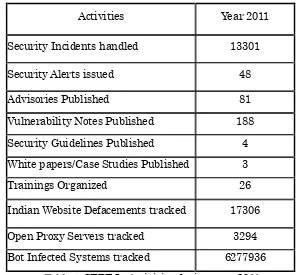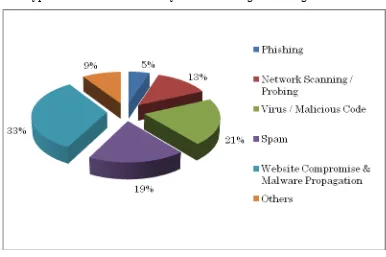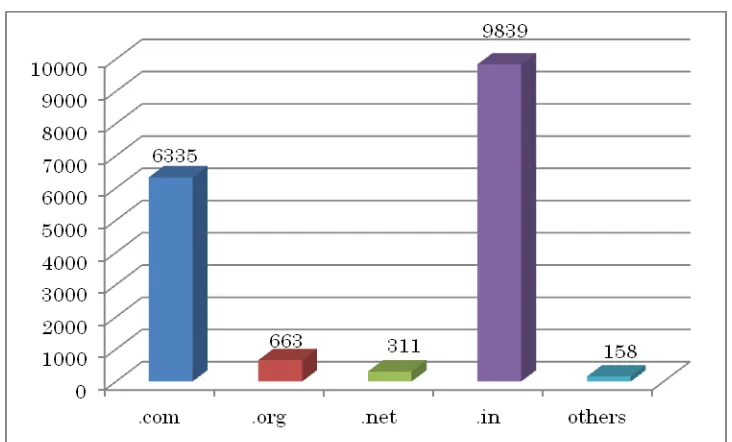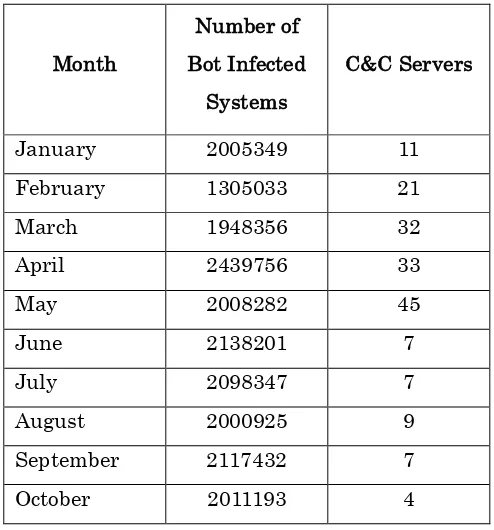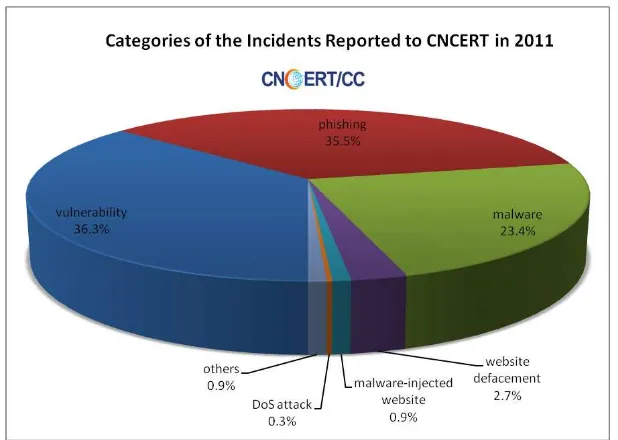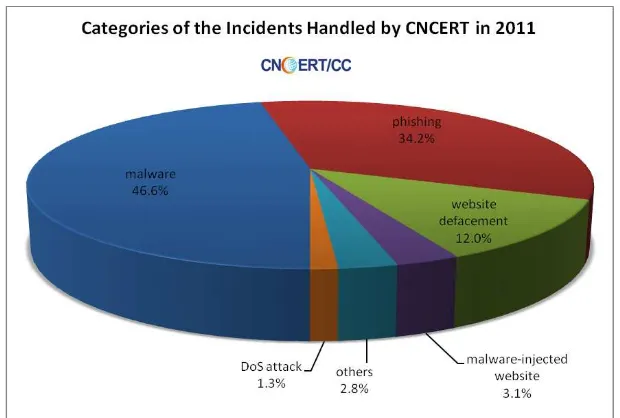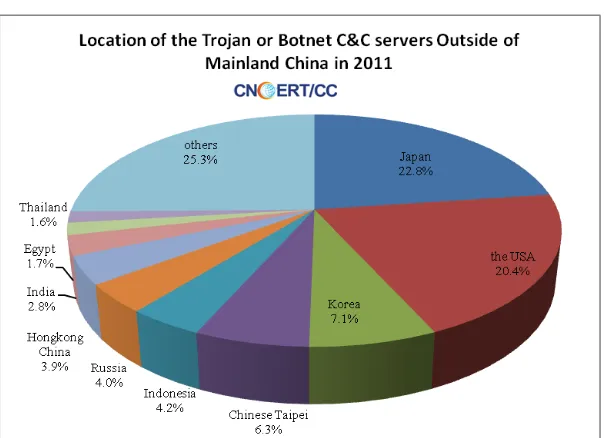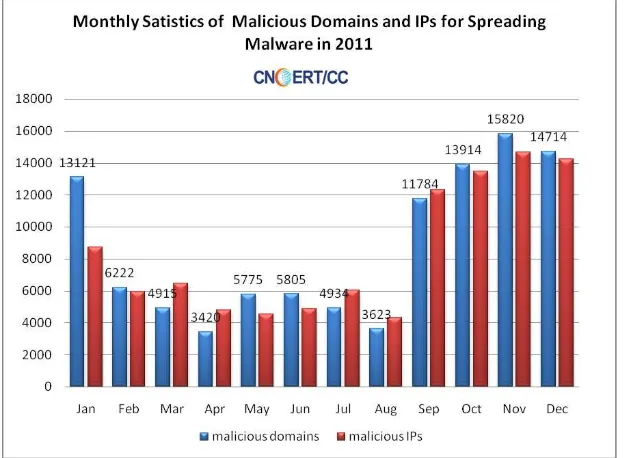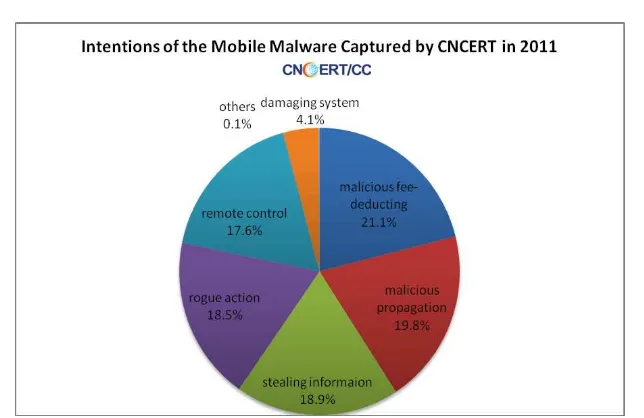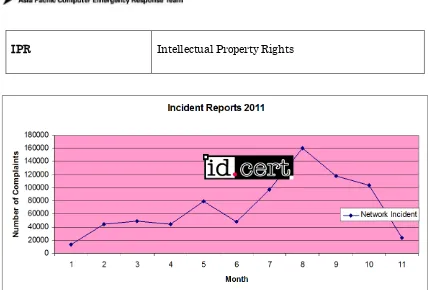1
A
A
P
P
C
C
E
E
R
R
T
T
A
A
n
n
n
n
u
u
a
a
l
l
R
R
e
e
p
p
o
o
r
r
t
t
2
2
0
0
1
1
1
1
2 CONTENTS
CONTENTS ... 2
Chair’s Message 2011 ... 4
I. About APCERT ... 6
II. APCERT Activity Report 2011 ... 12
1. International Activities and Engagements 12 2. Approval of New General Members / Full Members 15 3. APCERT SC Meetings 15 4. APCERT Survey 2011 15 III. Activity Reports from APCERT Members ... 17
Full Members 17
1. AusCERT Activity Report 17
2. BKIS Activity Report 22
3. BruCERT Activity Report 27
4. CERT-In Activity Report 32
5. CNCERT/CC Activity Report 42
6. HKCERT Activity Report 52
7. ID-CERT Activity Report 59
8. Id-SIRTII/CC Activity Report 66
9. JPCERT/CC Activity Report 72
10. KrCERT/CC Activity Report 81
11. MyCERT Activity Report 86
12. SingCERT Activity Report 96
13. Sri Lanka CERT/CC Activity Report 99
14. ThaiCERT Activity Report 111
15. TWCERT/CC Activity Report 118
16. TWNCERT Activity Report 130
3
General Members 143
18. BDCERT Activity Report 143
19. CERT Australia Activity Report 148
20. mmCERT Activity Report 154
21. MOCERT Activity Report 160
22. MonCIRT Activity Report 170
4
Chair’s Message 2011
After 9 years of successful collaboration and activities, APCERT updated its vision at the last Annual General Meeting in March 2011. Our new vision is “APCERT will work to help create a Safe, Clean and Reliable Cyber Space in the Asia Pacific Region through global collaboration.” Each member CSIRT serves its own constituency for security incident response and information infrastructure protection and APCERT members support each other to achieve that mission through membership in APCERT and participation in its forums and activities. APCERT also increasingly serves as a regional collaboration forum for members to work together and collaborate globally to improve the health and security of our shared common environment – the Internet. We must begin to implement strategies and approaches that work to improve the Internet ecosystem and its health in addition to protecting against and reacting to specific threats and incidents.
The APCERT members realize the need to jointly work and that global efforts are required to solve common cyber security challenges. We plan to contribute to making the Internet ecosystem cleaner and healthier as a basis for improved cyber security in the Asia Pacific as a mutual gain for all in the long-term. As a step, we participated global dialogues to discuss clean-up norms, signed MOU with Organization of Islamic Cooperation in September, kept closed engagement with other regional CERT frameworks, and AP regional policy frameworks and operation groups.
5 improvement.
APCERT will lead and move forward. We have built trust and strong collaboration with each other. Now we must deepen that collaboration and work with others to extend our efforts make cyberspace more safe and secure. I look forward to working with you all and our partners across the globe to make next year our most successful!
Yurie Ito, Chair, APCERT
6
I. About APCERT
1. Objectives and Scope of Activities
APCERT (Asia Pacific Computer Emergency Response Team) is a coalition of the forum of CERTs (Computer Emergency Response Teams) and CSIRTs (Computer
Security Incident Response Teams). The organization was established on
February 2003 to encourage and support the activities of CERTs/CSIRTs in the Asia Pacific region.
APCERT will maintain a trusted contact network of computer security experts in the Asia-pacific region to improve the regions’ awareness and competency in relation to computer security incidents through:
1. enhancing Asia-Pacific regional and international cooperation on information security;
2. jointly developing measures to deal with large-scale or regional network security incidents;
3. facilitating information sharing and technology exchange, including information security, computer virus and malicious code, among its members; 4. promoting collaborative research and development on subjects of interest to its
members;
5. assisting other CERTs and CSIRTs in the region to conduct efficient and effective computer emergency response;
6. providing inputs and/or recommendations to help address legal issues related to information security and emergency response across regional boundaries.
7
The geographical boundary of APCERT activities are the same as that of APNIC. The region covers the entire Asia-Pacific, comprising of 56 economies. The list of those economies is available at:
http://www.apnic.net/about-APNIC/organization/apnics-region
At present, APCERT Chair is JPCERT/CC (Japan Computer Emergency Response Team/Coordination Center). Deputy Chair is KrCERT/CC (Korea Internet Security Center). JPCERT/CC (Japan Computer Emergency Response Team/Coordination Center) serves as secretariat.
URL: http://www.apcert.org Email: [email protected].
2. APCERT Members
APCERT was formed in 2003 by 15 teams from 12 economies across the
Asia-Pacific region, and has increased its membership since then. In 2010,
TechCERT, MonCIRT and CERT Australia have been approved as General
Member of APCERT. Also, BruCERT has upgraded its membership to Full
Member of APCERT.
As of December 2011, APCERT consists of 28 teams from 19 economies across
the AP region, of which 19 teams are full members and 9 teams are general
members.
Full Members
Team Official Team Name Economy
AusCERT Australian Computer Emergency Response Team Australia Bkis Bach Khoa Internetwork Security Center Vietnam BruCERT Brunei Computer Emergency Response Team Negara Brunei
Darussalam CCERT CERNET Computer Emergency Response Team People’s Republic of
8
CERT-In Indian Computer Emergency Response Team India CNCERT/CC National Computer network Emergency Response
technical Team / Coordination Center of China
People’s Republic of China HKCERT Hong Kong Computer Emergency Response Team
Coordination Centre Hong Kong, China
ID-CERT Indonesia Computer Emergency Response Team Indonesia ID-SIRTII Indonesia Security Incident Response Team of
Internet Infrastructure Indonesia
JPCERT/CC Japan Computer Emergency Response Team /
Coordination Center Japan
KrCERT/CC Korea Internet Security Center Korea MyCERT Malaysian Computer Emergency Response Team Malaysia PHCERT Philippine Computer Emergency Response Team Philippine SingCERT Singapore Computer Emergency Response Team Singapore
Sri Lanka CERT/CC
Sri Lanka Computer Emergency Readiness Team
Coordination Centre Sri Lanka
ThaiCERT Thai Computer Emergency Response Team Thailand TWCERT/CC Taiwan Computer Emergency Response Team /
Coordination Center Chinese Taipei
TWNCERT Taiwan National Computer Emergency Response
Team Chinese Taipei
VNCERT Vietnam Computer Emergency Response Team Vietnam
General Members
Team Official Team Name Economy
BDCERT Bangladesh Computer Emergency Response Team Bangladesh BP DSIRT BP Digital Security Incident Response Team Singapore
CERT
Australia CERT Australia Australia
GCSIRT Government Computer Security and Incident
Response Team Philippines
mmCERT Myanmar Computer Emergency Response Team Myanmar MOCERT Macau Computer Emergency Response Team
9
MonCIRT Mongolian Cyber Incident Response Team Mongolia NUSCERT National University of Singapore Computer
Emergency Response Team Singapore
10 3. Steering Committee (SC)
Since the last APCERT AGM held in March 2010, in Jeju, Korea, the following members served as APCERT Steering Committee (SC).
• JPCERT/CC (Chair/Secretariat)
• KrCERT/CC (Deputy Chair)
• AusCERT
• HKCERT
• MyCERT
• SingCERT
• ThaiCERT
4. Working Groups (WG)
There are 5 Working Groups in APCERT.
1) TSUBAME WG (formed in 2009) • Objectives:
- Establish a common platform for Internet threat monitoring, information sharing & analyses in Asia-Pacific region
- Promote collaboration among CSIRT in Asia-Pacific region by using the common platform
- Enhance capability of global threat analyses by incorporating 3D
Visualization features to the common platform
• Members: JPCERT/CC (secretariat) and TSUBAME project members • S t a t u s : Active; Held TSUBAME Workshop in 2011
2) Information Classification WG (formed in 2011)
• Objective: To devise an appropriate information classification and handling system to be adopted for use by APCERT members when communicating or sharing information with each other
• Convener: Kathryn Kerr (AusCERT)
11 3) Information Sharing WG (formed in 2011)
• Objective: To identify different types of information that is regarded as useful for APCERT members to receive and/or which is available to share with other APCERT members.
• Convener: Yonglin Zhou (CNCERT/CC)
• S t a t u s : Active;
4) Membership WG (formed in 2011)
• Objective: To review the current membership criteria/classes and determine whether they should be broadened to include new criteria/classes and if so how should the new arrangements work.
• Convener: Jinhyun Cho (KrCERT/CC)
• S t a t u s : Active;
5) Operational Framework WG (formed in 2011)
• Objective: To identify changes that need to be made to the existing APCERT Operational Framework
• Convener: Roy Ko (HKCERT)
• S t a t u s : Active;
5. APCERT Website
12
II. APCERT Activity Report 2011
1. International Activities and Engagements
APCERT has been active in representing and promoting APCERT in various international events. From January 2011 to December 2011, APCERT members have hosted, participated and/or contributed in the following events:
• APCERT Drill 2011
http://www.apcert.org/documents/pdf/Drill2011_PressRelease.pdf
On 22 February, APCERT Drill 2011, the 7th APCERT Cyber Exercise Drill, was
successfully held with participation from 20 teams of 15 economies (Australia, Brunei, Bangladesh, China, Chinese Taipei, Hong Kong, India, Indonesia, Japan, Korea, Malaysia, Singapore, Sri Lanka, Thailand, and Vietnam). The theme of the drill was “Critical Infrastructure Protection” and was coordinated by SLCERT (Leader of the Organizing .Committee), TechCERT (Leader of the Exercise Control), CERT Australia, VNCERT, BKIS with advices from HKCERT and MYCERT.
• APCERT AGM & Conference 2011
The APCERT Annual General Meeting (AGM) & Conference 2011 took place in Lotte Hotel Jeju, Jeju Island, Korea, from 23-24 March, hosted by KrCERT/CC. The event brought together 19 team-representatives from 15 economies, and also guest speakers from other regions and local audiences.
The overall program of the event was as follows:
- 23 March Morning: AGM
- 23 March Afternoon: Conference (Closed to APCERT members and invited guests)
- 24 March Full-day: Conference (Open to public)
13
The event also provided opportunities for the teams to share information on trends of information security and some best practices of CSIRTs inside/outside the region.
• APCERT Workshop 2011 - TSUBAME Network Traffic Monitoring Project
APCERT Workshop 2011 on TSUBAME Network Traffic Monitoring Project, was held in the morning of 25 March, in conjunction with APCERT AGM & Conference 2011. The workshop was organized by JPCERT/CC to enhance the TSUBAME project and the cooperation among its members.
• CSIRT Trainings for AFRICA
JPCERT/CC organized trainings for African CSIRTs and introduced APCERT activities in this training on behalf of APCERT.
- 30 May to 4 June, Dar es Salaam, Tanzania - 19-22 November, Yaounde, Cameroon
• The Second Worldwide Cybersecurity Summit
The Second Worldwide Cybersecurity Summit organized by the EastWest Institute (EWI) was held in London from 1-2 June. There, Ms. Yurie Ito, the Chair of APCERT, joined the poster session, giving explanation on “Asia Pacific Regional Collaboration Activities in Making the Internet Clean, Safe and Reliable”.
• Annual National CSIRT Meeting
Annual National CSIRT Meeting hosted by the CERT Coordination Center was held in Vienna from 18-19 June. There, Ms. Yurie Ito, the Chair of APCERT, delivered a presentation entitled “Asia Pacific Regional Collaboration Activities in Making the Internet Clean, Safe and Reliable”.
• AP* Retreat Meeting
http://www.apstar.org/ap_retreat.php
14
Meeting, where organizations in the Asia Pacific region report and update their activities, was held in Busan on 2 September 2. There, Mr. Jinhyun Cho, the Deputy Chair of APCERT delivered a presentation entitled “APCERT Activities”.
• ACID (ASEAN CERT Incident Drill) 2011
ACID (ASEAN CERT Incident Drill) 2011, lead and coordinated by SingCERT, entered its sixth iteration this year with participation from ASEAN CERTs and APCERT Teams. The drill was completed successfully with focus on detection and investigation of attacks using common file formats as transmission vectors for exploit.
• APEC TEL 44
The meeting for Security and Prosperity Steering Group (SPSG) of the APEC-TEL was held in Kuala Lumpur on 27 September. There, Ms. Yurie Ito, the Chair of APCERT, delivered a presentation via video entitled “Introducing APCERT New Vision”.
• MOU between APCERT and OIC-CERT
http://www.apcert.org/documents/pdf/Joint-media-release-OIC-APCERT.pdf
APCERT and the Organisation of the Islamic Conference – CERT (OIC-CERT), has come to an agreement for the collaborative efforts amongst the OIC member countries and Asia Pacific region. The signing ceremony of this MOU was held on 27 September during the OIC-CERT Annual Conference 2011 in Dubai. Ms. Yurie Ito, the Chair was the signer.
• The 2nd APT Cybersecurity Forum
http://www.aptsec.org/2011-CSF
The 2nd APT Cybersecurity Forum, organized by the Asia Pacific Telecommunity and hosted by the Government of Japan, was held from 5-7 December in Tokyo, Japan.
Ms. Kaori Umemura of JPCERT/CC represented APCERT at this forum and presented on APCERT activities to the relevant participants.
15
• DotAsia
APCERT was invited to be a member of the Advisory Council of DotAsia, to assist DotAsia in policy development and relevant community projects. HKCERT represented APCERT in attending the meetings of the Advisory Council.
• FIRST (Forum of Incident Response and Security Teams)
Dr. Suguru Yamaguchi of JPCERT/CC is serving as Steering Committee member of FIRST from June 2011.
2. Approval of New General Members / Full Members
From January 2011 to December 2011, the following teams newly joined APCERT General Member / Full Member.
• MOCERT (Macao) was approved as General Member as of 4 March
• Id-SIRTII (Indonesia) was approved as Full Member as of 4 March
• mmCERT (Myanmar) was approved as General Member as of 7 December
3. APCERT SC Meetings
From January 2011 to December 2011, SC members held 1 face-to-face meeting and 7 teleconferences to discuss on APCERT operations and activities.
11 February Teleconference 4 March Teleconference 22 March Face-to-face meeting 20 April Teleconference 8 June Teleconference 10 August Teleconference 13 October Teleconference 7 December Teleconference
16
17
III. Activity Reports from APCERT Members
Full Members
1. AusCERT Activity Report
Australian Computer Emergency Response Team - Australia
About AusCERT
Introduction
AusCERT is the premier Computer Emergency Response Team (CERT) in Australia and a leading CERT in the Asia/Pacific region. AusCERT operates within a worldwide network of information security experts to provide computer incident prevention, response and mitigation strategies for members and assistance to affected parties in Australia. As a not-for-profit, self-funded organisation based at The University of Queensland, AusCERT relies on member subscriptions to cover its operating costs.
Establishment
AusCERT was the first Australian CSIRT and is one of the oldest CSIRTs, having been in continuous operation since 1993. AusCERT is on the steering committee of APCERT and is a member of FIRST.
Staffing
AusCERT has 13 staff members, including technical, administrative and managerial staff.
Constituency
AusCERT provides services to the Australian Internet community.
Activities and operations of AusCERT
Security advisories and bulletins
18 Incident response
AusCERT coordinates incident response on behalf of its members and generates pro-active reports of incident activity, based on its data collection activities. Weekly, AusCERT provides a report to each of its members that details activity that affected the member for that week.
Compromise evidence collection and data distribution
20 Certificate service
21 Stay Smart Online Alert Service
In 2011, AusCERT operated the Australian Government funded Stay Smart Online Alert Service and provided security alerts, advisories and newsletters to the Australian Internet community under this banner.
Events
AusCERT security conference
AusCERT hosts an annual information security conference in Queensland, on the Gold Coast. It attracts international speakers and attendees and is the largest event of its type in the southern hemisphere.
http://conference.auscert.org.au
AusCERT Security on the Move
AusCERT, in partnership with SC Magazine, began hosting “Security on the Move”, a one-day event that will rotate around major Australian capital cities.
Other events
AusCERT attended the following international events in 2011
• APCERT AGM and conference
• FIRST conference
AusCERT participated in the APCERT drill in February 2011.
Contacting AusCERT
AusCERT is contactable during Australian Eastern business hours and by its members 24x7.
22 2. BKIS Activity Report
Bach Khoa Internetwork Security Center – Vietnam
1.0 About Bkis - Vietnam
Bkis is a Vietnam’s leading organization in researching, deploying network security software and solution. Bkis was established on December 28th, 2001, and became full member of APCERT in 2003.
Head Office: 5th Floor, Hitech Building, Hanoi University of Technology, 1A Dai Co Viet, Hanoi, Vietnam.
2.0 Activities & Operations
2.1 Security Statistics in Vietnam
Overview of computer virus and network security in 2011:
According to statistics of Bkis HoneyPot, 64.2 million computers were infected by virus in 2011. In average, there were more than 175 thousands of computers infected each day.
23 List of 15 most infectious viruses in 2011:
The number of websites attacked in 2011
24 The hidden danger of W32.Sality.PE network
More than 4.2 million computers were infected by metamorphic virus W32.Sality.PE in 2011, in average 11,000 new computers got infected with this virus each day. Sality penetrated in every Vietnamese computer networks. Bkis experts found Sality existence in almost all systems they checked. Sality is not only the most spreading virus in 2011, but also a “time bomb” which can explode and affect millions of computers in the near future.
According to Bkis experts, during their time of tracking the virus from 2009, despite of its infection on millions of computers, Sality keeps “staying still” and hasn’t activated its destructive features like information stealing or data destroying. It’s difficult to explain. There might be an organization or even a country which backs up the virus network and their intention is still a mystery.
A reason which makes W32.Sality.PE be able to spread to millions of computers is its ability of using genetic algorithms to automatically generate the next virus generations F1, F2…The longer the virus infects the computer, the more complex the variants get, making it increasingly hard for antivirus software to detect and disinfect. Therefore, W32.Sality.PE can bypass almost all antivirus software in the world. Because of the seriousness of the problem, Bkis recommends that computer users should check their computers with antivirus software equipped with metamorphic virus disinfecting technique. Bkav users can use Bkav Pro to comprehensively remove this virus.
Phishing increased across social networks
By the end of 2010, Bkis experts predicted that many Internet phishing incidents would occur in 2011. It has happened. Bkis received more than 30 reports about phishing though Yahoo Messenger each month. In each event, the number of victims may reach ten. Despite being warned many times, a lot of users still lost their accounts or money due to their gullibility.
25
Social networks and online chat programs have become effective tools for hackers. Once again, Bkis recommends that users should be careful when receiving information through Internet communicating channels. Especially, users need to be vigilant with received links or files. They should call their friends to check if their chatting accounts require money or other sensitive information.
Botnet and consecutive network attacks
2011 was a year of network attacks. There were consecutive attacks towards Vietnamese enterprise’s networks with different methods. There were illegal penetrations to destroy database or deface websites. There were also DDoS attacks which made systems be paralytic in a long time. Many attacks aimed to rob domain names of enterprises. It was more dangerous that silent attacks happened with the installation of spy viruses to steal data from important organizations.
The attacks were mainly due to the lack of awareness about network security among the leaders of enterprises, organizations. This leads to wasteful investment and the lack of comprehensive solution for system security.
Specially, in 2011, more than 85,000 computers were installed Ramnit virus and stolen of important data. This shows the capability that the attacks may even influence a nation’s security. Besides, this botnet was controlled by hackers through many servers in US, Russia, Germany, China to steal data from all over the world, not only in Vietnam. This is a popular situation in the world in 2011.
2.2 Threat landscape in 2012 in Vietnam
Rootkit will not be a privilege of some hackers like before, but will become a new trend once this tool is publicized. Metamorphic virus will employ more new techniques to prolong the spread for years.
Due to the popularity of Windows 7 which is able to ensure high security level, the important execution decision is up to the users. Thus, there would be an in increasing growth of virus designed to fool users’ sense. Fake-icon virus is the first generation; and this trend is expected to continue in 2011.
Virus with socio-political motivation is to emerge more, taking advantage of popular software download websites to spread. Botnet which consists of the infected computers are used to perform attacks against targeted objects to steal confidential information from individuals and organizations.
26
assaults on cell phones to spread malicious codes, mainly in the form of hidden Trojan to steal users’ personal information.
3.0 Events organized / co-organized
3.1 Training Courses
Network Security Training Courses:
Jun 2011: For Network Administrators from companies (Banks...)
Security Awareness Training Courses: August 2011: 2 classes for Banks
3.2 Security Articles
In 2011, 20 security articles written by Bkis experts were posted on our security blog at security.bkis.vn.
3.3 Seminar
June 2011: Organized a seminar about security for e-government system. December 2011: Organized a seminar on securing e-journal systems.
4.0 International Collaboration
February 2012: Bkis took part in the APCERT Drill as a member of the organizing
27 3. BruCERT Activity Report
Brunei Computer Emergency Response Team – Negara Brunei Darussalam
1.0 About BruCERT
1.1 Introduction
Brunei National Computer Emergency Response Team (BruCERT) was established in May 2004. It was formed in collaboration with AITI, the Ministry of Communication, to become the nation’s first trusted one-stop referral agency in dealing with computer-related and internet-related security incidents in Brunei Darussalam.
The Brunei Computer Emergency Response Team Coordination Centre (BruCERT)
welcome reports on computer security related incident. Any computer related security incident can be reported to us by:
Telephone: (673) 2458001 Facsimile: (673) 2458002 Email: [email protected]
1.1.1 BruCERT Services
• 24X7 Security Related Incidents and Emergency Response from BruCERT.
• 24X7 Security Related Incidents and Emergency Response onsite (Deployment response is within 2hrs after an incident is received). This service only applies to BruCERT Constituents.
• Broadcast alerts (Early Warning) of new vulnerabilities, advisories, viruses and Security Guidelines from BruCERT Website. BruCERT Constituents will receive alerts through email and telephone as well as defense strategies in tackling IT Security related issues.
• Promote Security Awareness program to educate and increase public awareness and understanding of information security and technical know-how through education, workshop, seminar and training.
28
facilitate the detection, analysis and prevention of security incidents on the internet.
1.1.2 BruCERT Workforce
BruCERT currently with strength of 44 Staff (100% local) and the rest is administration. BruCERT has undergone training on various IT security module, such as A+, N+, Linux+, Server+, Security+, SCNP, SCNA, CIW, CEH, CCNA, CISSP and BS7799 Implementer, where most of BruCERT workforce has gain certification in certain fields.
1.1.3 BruCERT Constituents
BruCERT has close relationship with Government agencies, 2 major ISPs and various numbers of vendors.
Government Agencies
Provide a security incident response services to national and government agencies as ITPSS is appointed as a central hub for all IT security-related issues across the nation and to become the Government trusted E-Security Advisor.
AITI
Authority for Info-communications Technology Industry of Brunei Darussalam (AITI) is an independent statutory body to regulate, license and develop the local ICT industry and manage the national radio frequency spectrum.
AITI has appointed ITPSS (Information Technology Protective Security Services), an IT local security company to become the national CERT in dealing with incident response in Brunei.
Royal Brunei Police Force
BruCERT has been collaborating with RBPF to resolve computer-related incidents.
29
TELBru, the main service provider of internet gateway. and BruCERT have been working together to engage information sharing of internet-related statistics and the current situation of IT environment in Brunei.
DST –
The second largest internet service provider in Brunei.
2.0 BruCERT Activities and Operation in 2011
2.1 Incidents response
In 2011, BruCERT receive a few numbers of security incidents reports from the public even from the private sector. There were an increasing number of incidents that had been reported to BruCERT, which show positive feedbacks from the Brunei community. On the down side, there is also an increase number of website that had been defaced in Brunei. Most of the defacement are due to lack of security controls being placed and install security patches on the victims’ sides. The statistic of the security incident is shown as Figure 1.
30
Types of Attack Count
Virus 752
Spam 367
Scam 66
Cyber Harassment 3 Website Defacement 157
3.0 BruCERT Activities in 2011
3.1 Attended Seminars/Conferences/Meetings/Visits
BruCERT attended and presented at various seminars, conferences and meetings related to the field of ICT security.
On 22nd March until 25th 2011 - Two BruCERT delegates attended the
APCERT 2011 Annual General Meeting which takes place at Jeju Island South Korea.
On 26th until 28th September 2011, BruCERT Attended the OIC-CERT
Annual Conference 2011 and the 3rd Annual General Meeting.
In February 22nd 2011, BruCERT joined the APCERT Drill.
In September 27th 2011, BruCERT joined the ASEAN CERT Incident
Response Drill, where the main objective is to simulate realistic cross-border incidents handling and promote collaboration among national CERTs in the region
3.2 Training and Seminars
From November 21st until November 25th, BruCERT hosted the OIC-CERT Technical
31 4.0 Conclusion
32 4. CERT-In Activity Report
Indian Computer Emergency Response Team - India
1.0 About CERT-In:
1.1 Introduction
CERT-In is a functional organisation of Department of Information Technology, Ministry of Communications and Information Technology, Government of India, with the objective of securing Indian cyber space. CERT-In provides Incident Prevention and Response services as well as Security Quality Management Services.
The Information Technology Act 2000 designated CERT-In to serve as the national agency to perform the following functions in the area of cyber security:
• Collection, analysis and dissemination of information on cyber incidents
• Forecast and alerts of cyber security incidents
• Emergency measures for handling cyber security incidents
• Coordination of cyber incident response activities
• Issue guidelines, advisories, vulnerability notes and whitepapers relating to information security practices, procedures, prevention, response and reporting of cyber incidents
• Such other functions relating to cyber security as may be prescribed
1.1.1 Establishment
CERT-In was operational since January 2004. The constituency of CERT-In is the Indian cyber community. CERT-In works cooperatively with Chief Information Officers and system administrators of various sectoral and organisational networks of its constituency.
1.1.2 Workforce power
CERT-In has 30 member technical staff.
1.1.3 Constituency
33 2.0 Activities and Operations of CERT-In
CERT-In provides:
• Proactive services in the nature of Advisories, Security Alerts, Vulnerability Notes, and Security Guidelines to help organisations secure their systems and networks
• Reactive services when security incidents occur so as to minimize damage
2.1 Incident handling Reports
The summary of activities carried out by CERT-In during the year 2011 is given in the following table:
Activities Year 2011
Security Incidents handled 13301
Security Alerts issued 48
Advisories Published 81
Vulnerability Notes Published 188 Security Guidelines Published 4 White papers/Case Studies Published 3
Trainings Organized 26
[image:33.595.147.444.367.642.2]Indian Website Defacements tracked 17306 Open Proxy Servers tracked 3294 Bot Infected Systems tracked 6277936
Table 1. CERT-In Activities during year 2011
2.2 Abuse Statistics
In the year 2011, CERT-In handled more than 13000 incidents. The types of incidents handled were mostly of Phishing, Malicious Code, Website compromise & propagation of malware and Network Scanning & Probing.
34
Security Incidents 2004 2005 2006 2007 2008 2009 2010 2011
Phishing 3 101 339 392 604 374 508 674
Network Scanning /
Probing 11 40 177 223 265 303
277 1748
Virus / Malicious
Code 5 95 19 358 408
596 2817 2765
Spam - - - - 305 285 181 2480
Website Compromise
& Malware
Propagation
- - - - 835 6548 6344 4394
Others 4 18 17 264 148 160 188 1240
[image:34.595.89.575.123.365.2]Total 23 254 552 1237 2565 8266 10315 13301
Table 2.
Year-wise summary of Security Incidents handledVarious types of incidents handled by CERT-In are given in Figure 1.
Figure 1. Summary of incidents handled by CERT-In during 2011
2.3 Incident Trends
[image:34.595.104.490.417.674.2]35 during the year 2011 are as follows:
• Web site intrusions and drive-by-download attacks through compromised websites. Around 4394 malicious URLs were tracked in “.in” space. Most of the attacks were facilitated through attack tool kits such as Techno XPACK, Phoenix Exploit Kit, Neo spolit, Eleonre and Blackhole.
• Prominent client side vulnerabilities exploited in the drive by download attacks were in Adobe PDF, Flash, Java Runtime Environment, Interne Exporer and Mozilla Firefox.
• Malware trends indicate that malware affecting mobile platforms such as Android and Symbian were on the rise.
• Banking Trojans and key logger families were widely propagating. Prominent Trojans observed were ZeuS, Carberp, SpyEye, Torpig, Pushdo etc
• Rougue antivirus programs such as MacDefender, Winwebsec etc. were delivered to users through SEO poisoning
• Malicious Spam and identity theft schemes were leveraging Social networking sites and features therein
• Targeted attacks were on the rise involving exploitation vulnerabilities in Adobe PDF and MS Office.
2.4 Tracking of Indian Website Defacements
36
Figure 2. Indian websites defaced during 2011 (Top Level Domains)
Figure 2.1 .in ccTLD defacements during 2011
2.5 Tracking of Open Proxy Servers
37
Figure 3. Monthly statistics of Open Proxy Servers in 2011
2.6 Botnet Tracking and Mitigation
CERT-In is tracking Bots and Botnets involving Indian systems. After tracking the IP addresses of Command and Control servers and Bots operating within India, actions are being taken to clean the respective systems and prevent malicious activities. Figure 4 shows the number of Bot infected systems and Command & Control servers tracked in 2011.
Month
Number of Bot Infected
Systems
C&C Servers
January 2005349 11
February 1305033 21
March 1948356 32
April 2439756 33
May 2008282 45
June 2138201 7
July 2098347 7
August 2000925 9
September 2117432 7
[image:37.595.169.416.496.761.2]38
November 2051836 2
December 1437170 3
Figure 4. Botnet statistics in 2011
2.7 Collaborative Incident resolution
During the year 2011, CERT-In worked in collaboration with Microsoft and Internet Service Providers in India to detect and clean the botnet infected systems, specifically the “Waldec” and “Rustock” Botnets. The outcome was very encouraging.
CERT-In also working in close coordination with cyber security agencies such as Symantec, McAfee and Kaspersky for resolution of incidents of malware such as Stuxnet and Duqu.
2.8 Interaction with Sectoral CERTs
CERT-In plays the role of mother CERT and is regularly interacting with the cyber security officers of Sectoral CERTs in Defense, Finance, Power, Transport and other sectors to advise them in the matters related to cyber security.
2.9 Security Profiling and Audit Services
CERT-In is providing Security Profiling and Audit services to key organizations within the country to identify risks, threats and vulnerabilities in their IT assets and advise appropriate mitigations.
3.0 Events organized/ co-organized
3.1 Education and Training
To create awareness and to enable users to implement best practices, CERT-In is organizing workshops and training programmes on focused topics for targeted audience such as CISOs, financial and banking sector officers, System Administrators, ISPs etc. Experts from industry are delivering lectures in these workshops apart from CERT-In staff. CERT-In has conducted the following training programmes during 2011.
Workshop on "Secure Cloud Computing" on December 16, 2011
39
Workshop on "Advanced Internet Investigations & Cyber Forensics" on November 18, 2011
Workshop on "Secure Development Life Cycle" on November 15, 2011
Workshop on "Targeted Attacks & Mitigation" on November 04, 2011
Workshop on "Data Centre Security" on October 21, 2011
Workshop on "Log Management, Compliance & Auditing" on October 17, 2011
Workshop on "Phishing Attacks and Mitigation" on September 29, 2011
Workshop on "Web Application Security : Current threats & mitigation" on September 09, 2011
Workshop on "VoIP Security" on August 24, 2011
Workshop on "Introduction to Web Application Security" on August 17, 2011
Workshop on "Advanced Enterprise Security" on July 29, 2011
Workshop on "Network Penetration Testing" on July 15, 2011
Workshop on "Data Leakage Detection & Prevention" on June 24, 2011
Workshop on "Advanced Web Application Security" on June 17, 2011
Workshop on "Information Security Essentials" on June 10, 2011
Workshop on "Virtualization Security Challenges" on May 27, 2011
Workshop on "Advanced Cyber Forensics" on May 05, 2011
Workshop on "Vulnerability Assessment in Enterprise Networks and Applications" on April 08, 2011
Workshop on "Web Application Security - Current Trends" on March 18, 2011
Workshop on "Linux Security" on March 11, 2011
Workshop on "Network Perimeter Defence" on February 11, 2011
Workshop on "MySQL Database Server Security" on February 04, 2011
Workshop on "Introduction to Information Security" on January 28, 2011
Workshop on "Oracle Server Security" on January 17, 2011
Workshop on "SQL Server Security" on January 12, 2011
3.2 Drills
40 in February 2012.
At national level, CERT-In is carrying out mock drills with key sector organizations for assessing their preparedness in dealing with cyber crisis situation. These drills have helped in improving the cyber security posture of the information infrastructure and training of manpower to handle cyber security incidents, besides increasing the cyber security awareness among the key sector organizations. These drills at present are being carried out once in six months. Till date CERT-In has conducted 5 Cyber security drills of different complexities with 57 organizations covering various sectors of Indian economy i.e. Finance, Defence, Telecom/ISP, Transport, Power, Energy and IT industry.
4.0 Achievements
4.1 Publications
The following were published by CERT-In in the year 2011:
1. Securing Wireless Access Points/Routers: The purpose of the guideline is to recommend security practices for implementing Wi-Fi networks in Home and SOHO environments.
2. Monthly security bulletins: Monthly security bulletin comprises of Statistics of incidents handled by CERT-In, information on vulnerabilities in various Operating Systems and applications tracked, Cyber intrusion trends and other relevant IT security issues.
4.2 Certifications
Two technical members of CERT-In obtained GIAC Reverse Engineering Malware (GREM) Certification.
5.0 International collaboration
41 5.1 MoU
CERT-In and US-CERT singed MoU to enhance cooperation in the area of cyber security for rapid resolution of and recovery from cyber attacks.
As part of MoU with National Computer Board, Mauritius, CERT-In is providing advice to make CERT, Mauritius fully operational and becoming member of Forum of Incident Response and Security Teams (FIRST).
6.0 Future Plans/Projects
6.1 Future projects
CERT-In has been evolved as the most trusted referral agency in the area of information security in the country. Following are the future plans:
• Regular interaction with CISOs of Critical Infrastructure Organisations and sectorial CERTs to ensure security of the critical systems.
• Development and implementation of a crisis management framework to enable organisations to respond to cyber incidents and assess the preparedness of organisations to withstand cyber attacks
• Enhancing collaborations with IT product and security vendors to mitigate the vulnerabilities in various systems and cooperation with international CERTs and security organizations on information sharing and incident response
• Promotion of R&D activities in the areas of attack detection & prevention, Cyber Forensics and malware detection & prevention.
42 5. CNCERT/CC Activity Report
National Computer network Emergency Response technical Team / Coordination Center of China – People’s Republic of China
1. About CNCERT
1.1 Introduction
CNCERT (or CNCERT/CC) is a National level CERT organization under the leadership of MIIT (Ministry of Industry and Information Technology of the People's
Republic of China). It serves as the national network security monitoring,early
warning and emergency response center, as well as the key technical coordination
organization concerning security issues in public network. Therefore, the vital roles it plays are as follows:
• Monitoring public network security,
• Collecting, analyzing and publishing network security threats, • Notifying the communication industry of network security incidents,
• Receiving and handling network security incidents at home and
overseas,
• Exchanging network security information and cooperating with
international security organizations.
1.2 Establishment
CNCERT was founded in Sep., 1999, and became a member of FIRST in Aug 2002. It also took an active part in the establishment of APCERT as a founding member.
1.3 Workforce power
CNCERT, which is based in Beijing, the capital of P.R.China, has branch offices in 31
provinces, autonomous regions and municipalities of mainland China.
1.4 Constituency
The constituency of CNCERT includes the general public, government departments, the communication industry and the businesses in mainland China. It provides
43
monitoring, early warning and emergency response of control systems. Besides, it also
assists the international internet organization to resolve network security incidents if the sources or targets are localized in mainland China.
1.5 Contact
E-mail:[email protected]
Hotline:+8610 82990999(Chinese), 82991000(English)
Fax:+8610 82990375
PGP Key:http://www.cert.org.cn/cncert.asc
2. Activities & Operations
2.1 Incident handling reports
In 2011, CNCERT received 15,366 incidents reports1 which increased by 47.3% from
[image:43.595.144.453.429.649.2]10,433 in 2010. Most incident reports fell into the categories of vulnerability (36.3%), phishing (35.5%) and malware (23.4%) as shown in Figure 1.
Figure 1 Categories of the Incidents Reported to CNCERT in 2011
1In 2011, C NC ERT ha d no t e stima te d sp a m inc id e nt re p o rts in its d a ta c o lle c tio n. Inste a d ,
44
In 2011, CNCERT handled 10,924 incidents, a rise of 2.4 times compared with that of
[image:44.595.143.453.196.405.2]the previous year. As shown in Figure 2, malware (46.6%) dominated the categories of the incidents handles by CNCERT in 2011, followed by phishing (34.2%) and website defacement (12.0%).
Figure 2 Categories of the Incidents Handled by CNCERT in 2011
2.2 Abuse Statistics
2.2.1 Trojan & Botnet Monitoring
45
Figure 3 Location of the Trojan or Botnet C&C Servers Outside of Mainland China in 2010
2.2.2 Conficker Monitoring
Globally, there were over 35 million IPs of computer on average infected with Conficker each month. And China witnessed an average amount of 4 million IPs of computer fell victim to Conficker each month. As shown in Figure 4, the Top 5 affected disaster areas around the world were the USA (16.1%), mainland China (11.6%), Brazil (7.4%), Britain (3.8%) and India (3.2%).
[image:45.595.144.454.514.725.2]46 2.2.3 Malware Monitoring
[image:46.595.143.458.238.467.2]In 2011, CNCERT monitored and discovered 35,821,698 malware incidents, which involved 785,388 malware download links, 67,468 malware-hosting domain names and 55,673 malware-hosting IPs. Figure 5 depicts the number of the malicious domains and IPs for spreading malware, with the most rampant activity after September. Meanwhile, port 80 (46.7%) and port 8080 (32.3%) were employed by the majority of the malware in the course of spreading.
Figure 5 Monthly Statistics of Malicious Domains and IPs for Spreading Malware in 2011
2.2.4 Mobile Virus Monitoring
47
Figure 6 Intentions of the Mobile Malware Captured by CNCERT in 2011
2.2.5 Web Defacement Monitoring
According to CNCERT monitoring, 36,612 websites were defaced in mainland China in 2011, increasing by 5.1% from 34,845 in 2010. The defaced websites are categorized into .com & .com.cn, .gov.cn, .net & .net.cn, .org & .org.cn, .edu.cn and others based on their domains. As shown in Figure 7, .com & .com.cn still dominated the domain categories of the defaced website, while .gov.cn accounted for 9.6% with a considerable decrease of 39.4% in 2011.
[image:47.595.144.453.495.715.2]48 2.2.6 Phishing monitoring
From March to December in 2011, CNCERT monitored 3,841 domains of phishing websites masquerading as legitimate banks in mainland China, which were resolved to 667 IP addresses home and abroad. Figure 8 illustrates location of the phishing servers’ IPs, 72% of which were identified as in the USA.
Figure 8 Location of the Phishing Servers IPs in 2011
2.2.7 Backdoor monitoring
From April to December in 2011, CNCERT monitored 12,513 websites injected with backdoor in mainland China, including 1,167 government sites (.gov.cn). There were 11,851 source IPs of the attacks located outside of mainland China, mainly in the USA, Korea, Nigeria and Turkey.
49 3. Events organized/co-organized
3.1 Drills
CNCERT participated in three drills in 2011 to exercise incident response capacity and to mitigate the impact of ongoing internet attacks, enabling better coordination with local and international partners. These drills are as follows:
APCERT 2011 Drill-“Critical Infrastructure Protection”, on Feb. 23, 2011 MIIT (Ministry of Industry and Information Technology) 2011 Drill, on Jun. 7, 2011
ASEAN CERT Incident Drill (ACID) 2011, on Sep. 27, 2011
3.2 Conferences
Press Briefing of Report on 2010 Network Security Landscape
CNCERT co-hosted this briefing with the Communication Security Bureau of MIIT on March 9 in Beijing. The report analyzed the network security in 2010 and predicated security trend in the coming year with some countermeasures suggested.
2011 CNCERT Annual Conference
CNCERT hosted this conference from August 8 to 10in 2011 at Dalian city, China in the theme of ‘New Perspectives New Security’. The mission was presenting and sharing new emerging focus and concerns on network security, and discussing new countermeasures or approaches to deal with them.
4th China-ASEAN Network Security Seminar
CNCERT organized the 4th China-ASEAN Network Security Seminar in Dalian, China on August 8, 2011. The seminar offered an opportunity for the CNCERT and ASEAN delegates to exchange network security technology and management experience and to strengthen bilateral cooperation mechanisms.
Symposium on “Fighting Spam to Build Trust”
50
Group (MAAWG) at the EWI’s Second Cybersecurity Summit, which was held on June 1 to 2 in London. The participants discussed how to set up the international anti-spam forum and to implement the best practices.
4. Achievements
4.1 Publication
Figure 12 lists publications of CNCERT throughout the year 2011.
Name Issues Description
Weekly Report of CNCERT (Chinese)
52 Emailed to over 430 organizations and individuals and published on
CNCERT’s website (http://www.cert.org.cn/)
Weekly Report of CNCERT (English)
18 Emailed to over 430 organizations and individuals and published on the English page of CNCERT’s website
(http://www.cert.org.cn/english_we b/documents.htm)
CNCERT Monthly Reports on Internet Security Threats (Chinese)
11 Issued to over 400 organizations and individuals on regular basis and published on CNCERT’s website (http://www.cert.org.cn/) Annual Report on Network
Security (Chinese)
1 Published on CNCERT’s website (http://www.cert.org.cn/)
CNVD Vulnerability Weekly Report (Chinese)
52 published on CNCERT’s website (http://www.cert.org.cn/)
Network Security Alerts (Chinese)
41 published on CNCERT’s website (http://www.cert.org.cn/)
Fighting Spam to Build Trust (Chinese and English)
1 http://www.cert.org.cn/articles/activ ities/common/2011081625464.shtm l
http://www.ewi.info/fighting-spam-51
build-trust
5. Conferences attended & speeches delivered
APCERT Annual Conference and Annual General Meeting
This conference was held from March 22 to 25 at Jeju, Korea. In the conference, China delivered the speech on the network security status in China, initiated and chaired the information sharing workgroup and actively joined discussions to promote the role of CNCERT in international mutual and multi-lateral cooperation.
43rd and 44th Meetings of the APEC Telecommunications and Information Working Group (TEL)
The 43rd and 44th Meetings of the APEC TEL were held in March and September respectively. CNCERT attended the workgroup session especially on network security.
23th Annual FIRST Conference and 2011 Annual Meeting for CSIRTs with National Responsibility
These two conferences were held in Vienna, Austria from June 6 to 12. CNCERT delivered a keynote speech on technical requirements for national-level CSIRT as well as potential challenges and development directions in future, which were well recognized by the participants.
6th China-ASEAN Telecom Round Table Seminar
52 6. HKCERT Activity Report
Hong Kong Computer Emergency Response Team Coordination Centre - Hong Kong, China
1. About HKCERT
1.1 Establishment
Hong Kong Computer Emergency Response Team Coordination Centre (HKCERT) was established in 2001 with funding from the Hong Kong Special Administrative Region (HKSAR) Government. The Hong Kong Productivity Council (HKPC), which is a government subvented organization in Hong Kong, has operated the centre since then.
1.2 Mission and Constituency
HKCERT is the centre of coordination of computer security incident response for local enterprises and Internet users in Hong Kong. Her missions are to handle computer security incident reports, gather and disseminate information relating to security issues, advise on preventive measures against security threats, promote information security awareness, and maintain network with other computer emergency response teams (CERT) and security organizations to facilitate coordination and collaboration.
1.3 Organization
The senior management of HKPC oversees the overall direction and operation of the centre. The daily operations are taken care by the Centre Manager, two consultants and a group of computer security specialists.
2. Operations and Activities
2.1 Incident Handling
53
During the period from January to December of 2011, HKCERT had handled 975 incidents, including 810 security incidents, 145 virus incidents and 20 other incidents. Security incident reports continue to overtake virus incident reports (See Figure 1).
Figure 1. HKCERT Incident Reports in 2011
The number of incidents reported by local parties was 400 (34.3%), by overseas parties was 405 (34.7%) and by proactive discovery was 360 (30.9%).
Source locality of reports 2010 2011
Local parties 360 (26.3%) 400 (34.3%)
Overseas parties 554 (40.6%) 405 (34.7%) Proactive discovery 452 (33.1%) 360 (30.9%) The continuing low local reports indicated that malware nowadays are
more stealth than before. We have to do more awareness promotion to educate the general public about the threats.
The significant number of cross border incidents reflected the globalization of cyber attacks and a need for building strong international collaboration. We have to conduct proactively research to effectively discover previous
unreported incidents.
54 Top 3 incident types
via Proactive Discovery
2010 2011
1 Defacement (33.4%) Defacement (33.9%)
2 Phishing (31.6%) Malware (25.8%)
3 Code Injection (14.8%) Phishing (23.9.9%)
2.2 Information Gathering and Dissemination
HKCERT collected security-related information from security organizations, made judgments on the impact to Hong Kong, and decided whether to disseminate the information. During the period from January to December of 2011, HKCERT published 343 security bulletins and advisories (See Figure 2) which is an 11% increase from previous year’s number (i.e. 308). All security bulletins were related to vulnerabilities and no malware alert was published during this period.
Figure 2. HKCERT Published Security Bulletins in 2011
2.3 Publications
We had published 12 issues of monthly e-Newsletter in the period.
55
Figure 3. HKCERT RSS Visitors Count in 2011
3. Security Awareness and Training
3.1 Seminars, Conference and Meetings
HKCERT jointly organized the Hong Kong Clean PC Day 2011 campaign with the Government and Police. The campaign involved public seminars, cyber security symposium and a screensaver contest. Five public seminars were organized in March, June, August, October and December 2011.
We organized the Information Security Summit 2011 with other organizations and associations in November 2011, inviting local and international speakers to provide insights and updates to local corporate users.
3.2 Training
We coordinated two overseas expert and two local experts to deliver three speeches and three hands-on workshop on “Analysis and Reverse Engineering Android Malware”, “Deploying a Secure Private Cloud” and “Penetration Test Kungfu with BackTrack” in the training workshops of the Information Security Summit.
3.3 Speeches and Presentations
HKCERT was invited to deliver speeches and presentations on various occasions for Government, associations and schools.
3.4 Media briefings and responses
56
4. Coordination and collaboration
4.1 International Collaboration
HKCERT participated in a number of international coordination and collaboration events:
4.1.1 Collaboration with CERT community
Served in the APCERT Steering Committee in 2010-2012; elected as the Chair for 2010-2011
Participated in APCERT AGM and Conference 2011 in Jeju, Korea (March 2011)
Participated in both the FIRST AGM and Conference 2011, organized by FIRST, and the Annual Meeting for CSIRTs with National Responsibility, organized by CERT/CC in Vienna, Austria (June 2011)
Participated in the APCERT Drill (Feb 2011) and also acted was the Exercise Control team member. The theme of the drill this year was “Critical Infrastructure Protection”. The drill was a great success with 20 APCERT from 17 economies participating.
Joined the Tsubame distributed honeypot project of JPCERT/CC
Liaised with Macao CERT (MOCERT) in her application to APCERT and FIRST and paid a site visit to MOCERT (May 2011)
4.1.2 Collaboration with other international organizations
Represented APCERT in the Advisory Council of DotAsia Organization Joined the Microsoft Security Cooperation Program to share information Participated in Digital Crime Consortium Conference in the Bahama
Islands, organized by Microsoft (Oct 2011)
Participated in Honeynet Project Workshop 2011 in Paris (March 2011) Participated in the AVAR Conference in Hong Kong (Nov 2011)
4.2 Local Collaboration
57
Continued to work closely with the government and law enforcement agency, and held meetings to exchange information and to organize joint events regularly
Continued to work with police, ISPs and domain registries on closing down bulletproof hosting, phishing sites and botnet command and control centres in Hong Kong. HKCERT is still working closely with HKIRC on pre-empting the risks caused by Conficker worm generating pseudo-random domains with “.hk”.
Co-organized a local drill with HK Police and OGCIO on 4th November
2011 on web forum incident response. HKCERT led the preparation of the scenarios and acted as the lead of EXCON of the drill. The drill was a great success.
Participated in the government's Information Infrastructure Liaison Group and Information Security Task Force and provided security status reporting during World IPv6 Day, and important events such as the policy address of CE and the budget speech
Maintained the Information Security Advisory and Collaboration (ISAC) Mailing list and advised on latest information security issues through the list
Organized a round table discussion meeting with information security organizations
5. Other Activities
5.1 Year Ender press briefing
HKCERT organizes a year ender press briefing to media at the beginning of each year, to report on information security status in the past year, and to give perspective of the trends of security attacks in the coming year to warn the public for better awareness and preparedness.
The 2011 year ender briefing was held on 4th January 2012.
5.2 Website revamp
58
website was enhanced by adopting SSL protection for all pages. In the new website, security bulletins would be given severity rating to help users to prioritize their mitigation measures.
6. Future Plans
6.1 Funding
HKCERT would secure Government funding to provide the basic CERT services in 2012/2013. We shall work closely with the government to plan for the future services of HKCERT.
We shall continue to propose new initiatives to the government and seek support from the government.
6.2 Enhancement Areas
**HKCERT had conducted a strategic review of services by JPCERT/CC in late 2009. The review had pointed out areas for improvement which we are working on thean strategic plan to incorporate implementation plan on these recommendations in future plan and seek funding to support them. They include enhancement of incident management system, proactive discovery of security incidents, intelligence collection,
59 7. ID-CERT Activity Report
Indonesia Computer Emergency Response Team - Indonesia
1. About ID-CERT
1.1 Introduction
ID-CERT (Indonesia Computer Emergency Response Team) is an independent team which is from and for community. ID-CERT is the first CERT in Indonesia and founded by DR. Budi Rahardjo in 1998. ID-CERT together with JP-CERT (Japan), AusCERT (Australia) is one of the founders of the APCERT (Asia Pacific Computer Emergency Response Team) forum.
1.2. Establishment
In 1998 there was no CERT in Indonesia. Based on that DR. Budi Rahardjo, an internet security expert, encouraged himself to establish ID-CERT. At the same time countries around Indonesia began to establish their own CERTs and this continued into Asia-Pacific forum which later became the APCERT.
ID-CERT wishes to remain standing as a non-governmental organization, independent, but received an allocation of government funding as a contribution to the CERT. ID-CERT is just being reactive (not active) in responding and handling a case of incoming or reported incident by complainers. ID-CERT does not have the authority to investigate a case thoroughly, but just become a liaison who can be trusted, especially by those who reported incident.
1.3 Workforce power
During 2011 complaints received by ID-CERT were still handled by Dr. Budi Rahardjo and Andika Triwidada. Since January, 2011 Ahmad Alkazimy was recruited after being volunteer in research activity since March, 2007.
1.4 Constituency & Etc.
60
In addition, ID-CERT also had succeeded in formulating its mission together with the community and its constituents. The missions are:
1. ID-CERT’s purpose is to coordinate the incidents handling involving community locally and internationally.
2. ID-CERT does not have operational authority to its constituency, it only informs a variety of complaints to network incidents, and depends entirely on the cooperation with all those involved in incidents related networks.
3. ID-CERT is built from community and the results will be given back to the community.
4. ID-CERT helps increasing the internet security awareness in Indonesia. 5. ID-CERT has research in internet security which is needed by the Indonesia
internet community.
2. Activities and Operations
2.1. Activities
2.1.1 Incident Handling Reports Abuse category consists of:
Spam Spam complaints received from abroad to the network in Indonesia
Spam Complaint Spam complaints received from domestic/local to the network in Indonesia and abroad
Response The response provided by all parties on incoming reports
Network Incident Activities carried out on other people’s networks as well as all activities related to network abuse
Fraud Report misuse of credit cards. This definition is based on reports police/law enforcement
Spoofing / Phishing E-mail scams and websites to deceive users
61
[image:61.595.91.519.74.364.2]IPR Intellectual Property Rights
Figure 1: Incident Handling Reports 2011
Most of the complaints that ID-CERT received on 2011 from the communities were Network Incident.
Figure 2: Incident Handling Reports 2011
[image:61.595.96.518.473.676.2]62 2.1.2 Research on Indonesia Internet Abuse 2011
The research initiated several years ago in creating Internet Security statistics based on reports received by ID-CERT only.
In 2011 ID-CERT added more respondents to get more data besides the current one from ID-CERT. Totally 45 respondents had joined the Internet Abuse research by the end of 2011, including ID-CERT, PANDI (ccTLD-ID Registry), 3 Ministry Offices, 5 telecommunication operators, 7 NAPs, 25 ISPs, and 2 foreign respondents. The type of data ID-CERT got from the respondents were Summaries of Abuse reports received by each respondent or email copies of Abuse reports received by each respondent.
[image:62.595.92.528.409.680.2]In contrast to reports received by the ID-CERT itself, the amount of average consolidated complaint received through Internet Abuse Research in 2011 amounted to 26,095 reports.
Figure 2: Research on Indonesia Internet Abuse Statistics 2011 (Monthly average, in %)
63
43 local and 2 foreign respondents. The biggest level was the network incident, followed by the second large complaints were the spam.
2.2. Operations
E-mail [email protected] was activated in January 1, 2011 to receive data from Research on Internet Abuse respondents.
E-mail [email protected] was also created to receive complaints.
ID-CERT plans to create some complaint e-mails which clasified based on most reports received.
3. Events
In February 28, 2011 ID-CERT had its third Public Gathering in Jakarta. A number of topics were discussed in the gathering, they are:
1. Current and future services 2. Abuse Research update 3. Funding
4. Formalizing ID-CERT Framework based on RFC2350.
In March 22-25, 2011, the APCERT AGM was held in Jeju, South Korea. ID-CERT could attend it after absent for several years. Thanks to APCERT and KrCERT for facilitating it.
4. Collaboration
4.1 Local
In July 2011 the first meeting between ID-CERT and APJII continued to have an MoU in November 2011.
64
ID-CERT was invited several times by KAMINFO in some events, such as Workshop of Handling Information Security Incident and Indonesia Internet Security Forum (IISF), and as a keynote speaker in CERT Regulation meeting.
4.2 International
ID-CERT got email feed from some foreign organizations for all IP address and domain names related to Indonesia. Some foreigner CSIRTs from Europe to Latin America (including GovCERT and Financial CERT) often make coordination with and asking help from ID-CERT.
5. Future Plan
ID-CERT has a number of plans related to future development of ID-CERT.
First thing to do, ID-CERT will employ several full-time staffs to increase incident handling capacity. A response help desk officer will be recruited soon. ID-CERT will also plan to send its staff for an internship to another CERT. It means that the employee of ID-CERT could have a complete picture of CERT services in general.
Second one, ID-CERT will deploy a system to manage and handle incidents better. ID-CERT will prepare the workflow and Standard Operation Procedures (SOP).
In addition, research activities, such as Abuse Research, a local product of ID-CERT for the needs of their constituents, will continue to work on. ID-CERT plans to maintain the data until the next few years.
ID-CERT will prepare several other researches and studies, required by Indonesia internet community. ID-CERT also plans to add personnel in the field of research and collaboration with leading universities in developing any necessary research.
ID-CERT will publish regular research reports per month, per bi-monthly, per semester, and annual report.
65 6. Contact Information
Web : http://www.cert.or.id
E-mail : [email protected] (incident complaint)
[email protected] (Internet Abuse Research)
Phone : +62 838 74 9292 15 (Mr. Ahmad Alkazimy)
PGP Keys :
Mr. Andika Triwidada E-mail: [email protected]
Fingerprint=5568 7C7D E898 4F33 A594 A996 DA4B C29F E22D FEE7
Mr. Ahmad Alkazimy E-mail: [email protected]
Fingerprint=39B2 87BA 3DD6 7832 D56F 0344 FCE4 3A7C FE38 CC96
7. Conclusion
After facing the hard times, ID-CERT attempted to rise again as a community-based CERT.
As for the future based on ID-CERT’s views: in Indonesia, will appear more sectors CERT such as banking CERT, government CERT, education CERT, etc based on the need of their own community to coordinating to each other.
In the year 2011, though only a few abuse reports that come in, ID-CERT planned to continue enhancing the ability of ID-CERT personnel through training and plan for internship.
66 8. Id-SIRTII/CC Activity Report
Indonesia Security Incident Response Team on Internet Infrastructure - Indonesia
1. About Id-SIRTII/CC
1.1 Introduction
Id-SIRTII/CC is the national CSIRT/CC of Indonesia. The purpose of Id-SIRTII is to coordinate security efforts and incident response for critical infrastructure and IT-security problems on a national level in Indonesia.
1.2 Establishment
Id-SIRTII/CC was established in 2006 by ICT Minister Decree Number 27/2006 and 26/2007 then revised with 16/2010. On 2010 became a full member of APCERT. On 2011 became a member of FIRST and also National CSIRT Forum. On 2009 became a member of OIC-CERT.
1.3 Workforce Power
Id-SIRTII/CC now has 6-team member, which is Chairman and 5 deputy (Vice Chairman). For supporting daily operations we employ 35 staffs in our office at Jakarta the Capital City of Indonesia.
1.4 Constituency etc. Our constituencies are:
- IT security teams (public sectors)
- Internet Service Provider (ISP)
- Network Access Provider (NAP)
-
